Weekly Topics/Archive
October 2013
|
Since I was freed from caring for my old dog and so liberated from time
constraints,
I decided to resume visiting early temples in Minami Yamashiro.
It's because their hidden treasures and Buddhist statues happen to be opend
to the public.
Today I visit Gansen-ji and Joruri-ji Temples which are located in Kamo
Town, Kizugawa City, Minami Yamashiro.
There are many early temples around here.
Is it because it's located very close to Nara in which Buddhist culture
once flourished?
It's said that it became the places where Buddhist monks who disliked a
secularization
of temples train.
I rode “Miyakoji Rapid Service” from JR Kyoto to Kizu station and then
changed trains
to the Yamatoji Line to get to Kamo station.
I bought a one-day ticket at the temporary information desk in front of
the ticket gate.
I also got a convenient sightseeing brochure for Kizugawa city.
I got on a Kizugawa City Community Bus at the Kamo Station east exit and
got off
at Gansen-ji bus stop after about 15 minutes or so.
Gansen-ji is the temple of the Shingon Risshu sect of Buddhism.
The principal image is Amida Nyorai ( Amitabha Tathagata).
According to temple legend, it is reputed to have been founded by a Buddhist
monk, Gyoki.
When we climb stone steps leading out of the approach, we get to the main
gate.
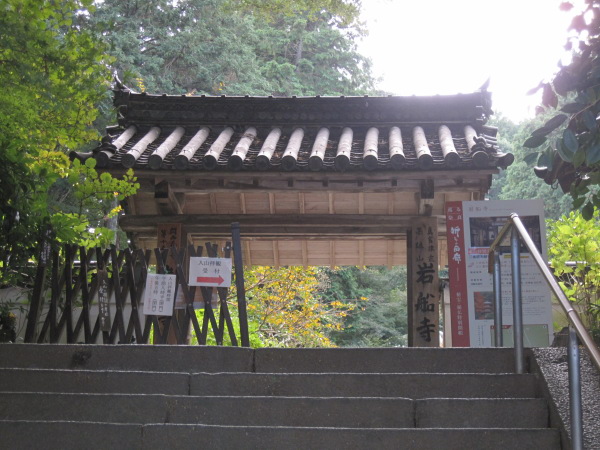
The main gate of Gansen-ji Temple |
|
When I entered the temple ground after paying an entrance fee of 400 yen, I can see
a main hall (main temple building) on my right and a bright vermilion three-storied pagoda
in a front grove.

The three-storied pagoda of Gansen-ji temple (Important cultural property) |
|
Since the pagoda has an engraved inscription of “2nd year of the Kakitsu
era (1442)”,
it's considered that the pagoda was constructed in this year.
Today the first story of the pagoda was specially opened to the public
and so I could see
the paintings on the inside walls.
They are brightly-colored buddhist paintings !
It's that they were restored to their original states with pagoda by the
Great Heisei
Repairs which were completed in 2003.

The paintings on the inside walls of the three-storied pagoda |
|
The following is the main hall reconstructed in 1988.
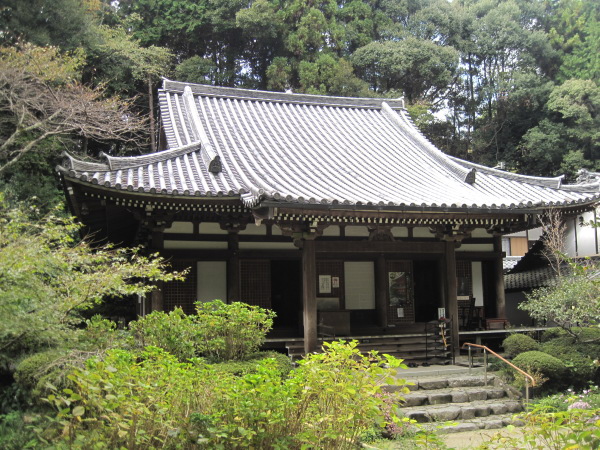
The main hall of Gansen-ji temple |
|
On the stand called Shumidan at the center on the front in the main hall,
the principal
image, seated statue of Amida Nyorai is enshrined.
It's a large statue with height of close to 3 meters.
Squarely standing statues of Shitenno are enshrined as Flanking Samurais.
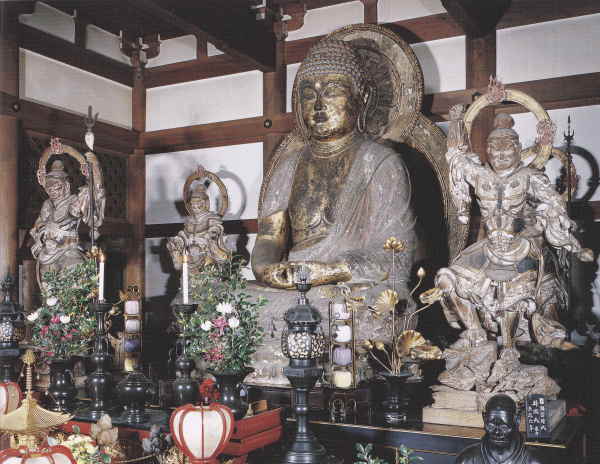
Seated statue of Amida Nyorai (Heian Period, Important cultural property)
& Standing statues of Shitenno (Kamakura Period)
Source; Reproduced from the Old Temples in Minamiyamashiro, 3rd Ed (Asukaen
Inc.). |
|
In addition to these statues, a standing statue of Amida Nyorai which
I wanted to see
and a statue of Fugen Bosatsu riding on an elephant is enshrined.
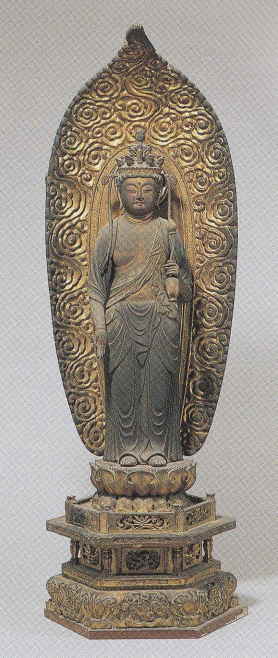
Standing statue of Eleven-faced Kannon
Bosatsu (Kamakura Period) |
|
|
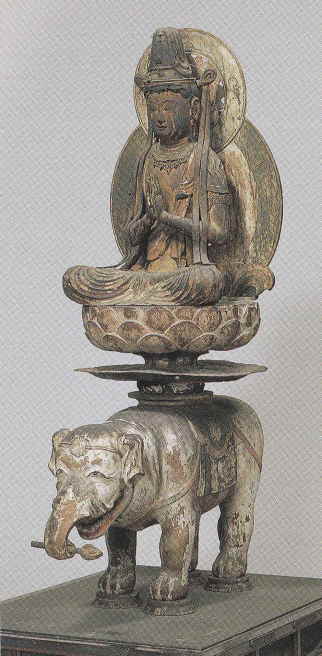
Statue of Fugen Bosatsu riding on an elephant
(Heian Period, Important cultural property) |
|
| Source; Reproduced from the brochure “Gansenji”. |
Standing statue of Eleven-faced Kannon Bosatsu has a water jar with left
hand and takes the form of Yogan-in (wish-granting mudra).
It's 55.5 cm tall and has soft features.
According to expert, the ancient style is left in its shape of body and
clothes.
This area is rich in granite.
Even in this temple ground, there are several good stone buddhist images
and stone
buildings.
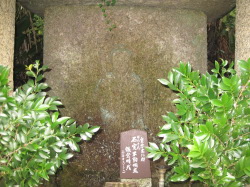
Standing statue of Fudo Myoo sculptured
on a stone (Kamakura Period,
Important cultural property) |
|
Gorinto tower (Five-ring pagoda)
(Kamakura Period, Important cultural property)
|
After visiting the temple for about an hour, I headed to Joruri-ji temple
by bus.
For more detail on Gansen-ji temple, please see the following picture.
 Picture / Pilgrimage to old temples / “Kouyuzan Gansen-ji temple” Picture / Pilgrimage to old temples / “Kouyuzan Gansen-ji temple”
Photographing date ; October27, 2013
To be continued Weekly Topics / No.203−Oct 27, 2013 / Weekly Topics / No.203−Oct 27, 2013 /
“A Pilgrimage to Ancient Temples in Minami Yamashiro (Part1)−Joruri-ji temple−”
(Coming soon. Don't miss it!)
[Note] be freed from 〜/ be liberated from 〜 ; 〜から開放される
time constraint ; 時間的制約,resume ; (中断していたことを)再開する
visiting early temples ; 古寺巡り, hidden treasure ; 秘宝
flourish ; 栄える,secularization ; 世俗化,Miyakoji Rapid Service; みやこ路快速
change trains to the 〜 Line ; 〜線に乗換える,temporary ; 臨時の
sightseeing brochure for Kizugawa city ; 木津川市の観光パンフレット
Shingon Risshu sect of Buddhism ; 真言律宗,principal image ; 本尊
Amida Nyorai ( Amitabha Tathagata) ; 阿弥陀如来,temple legend ; 寺伝
be reputed ; 一般に〜と伝えられる, approach ; 参道,vermilion ; 朱色の
in a grove ;木立の中に,2nd year of the Kakitsu era ; 嘉吉2年
engraved inscription ; 刻銘、 buddhist painting ; 仏画
restore to original state;復原する, Great Heisei Repairs ; 平成の大修理
seated statue of Amida Nyorai; 阿弥陀如来坐像、squarely ; 四隅に
Flanking Samurai;脇侍, water jar;水瓶
statue of Fugen Bosatsu riding on an elephant;普賢菩薩騎象像
Yogan-in (wish-granting mudra);与願印, mudra ; (サンストリック語の)身ぶり
wish-granting;願望を与えること, 与願、soft features;柔和な顔立ち
be rich in 〜 ; 〜 が豊富である, granite;花崗岩
 TOPペ−ジへ戻る TOPペ−ジへ戻る
|
|